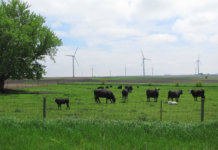The American Wind Energy Association (AWEA) has called on Gov. John Kasich, R-Ohio, to use his line item veto to strike a provision in H.B.483 that places restrictive setbacks on new Ohio wind farms. According to the group, the provision jeopardizes billions of dollars in potential wind investments.
‘This would kill further wind energy development in Ohio unless the governor vetoes it,’ says Rob Gramlich, AWEA's senior vice president of public policy.
Ohio's General Assembly changed the state's setback requirements last year from 925 ft. to a minimum of 1,300 ft. from inhabited residential structures. AWEA argues that because H.B.483 revises those requirements to apply to a turbine's distance from property lines, not just homes, the bill's provision would make it impossible to cost-effectively site any further wind farms in Ohio.
For example, the association says that had these proposed setback standards been applied to the state's largest wind farm, the 304 MW Blue Creek project, when it was developed, the number of turbines comprising the facility would have been reduced from 152 to 12.
AWEA further says the setback provision was adopted by the legislature only after public testimony on the bill ended: Relevant stakeholders such as AWEA, the Ohio Power Siting Board and wind developers active in Ohio were not able to provide testimony or technical data on the setback provisions and the resulting impacts.
‘The current wind energy development regulatory process in Ohio protects public safety and health and is already one of the most restrictive in the country," adds Gramlich. "The existing setback requirements were updated just eight months ago. By requesting the governor to line item veto, we are asking for the opportunity to engage in a constructive dialogue about wind energy development in Ohio."
AWEA also estimates that wind projects currently under development in Ohio represent an approximately $2.5 billion investment, which if fully developed, could provide about $220 million in local tax payments and $180 million to landowners over the projects' lifetimes.
Notably, H.B.483 isn't the only legislation that the wind industry has its proverbial eye on in Ohio. S.B.310, a bill that would freeze the state's clean energy and energy efficiency mandates for two years, passed the state legislature last month and awaits Gov. Kasich's signature or veto.



